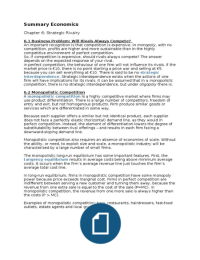Summary Economics
Chapter 6: Strategic Rivalry
6.1 Business Problem: Will Rivals Always Compete?
An important recognition is that competition is expensive. In monopoly, with no
competition, profits are higher and more sustainable than in the highly
competitive environment of perfect competition.
So, if competition is expensive, should rivals always compete? The answer
depends on the expected response of your rival.
In perfect competition, the behaviour of one firm will not influence its rivals. If the
market price is €10, there is no point starting a price war and selling at €5
because you can sell everything at €10. There is said to be no strategic
interdependence. Strategic interdependence exists when the actions of one
firm will have implications for its rivals. It can be assumed that in a monopolistic
competition, there is no strategic interdependence, but under oligopoly there is.
6.2 Monopolistic Competition
A monopolistic competition is a highly competitive market where firms may
use product differentiation. There is a large number of competitors, freedom of
entry and exit, but not homogenous products. Firm produce similar goods or
services which are differentiated in some way.
Because each supplier offers a similar but not identical product, each supplier
does not face a perfectly elastic (horizontal) demand line, as they would in
perfect competition. Instead, the element of differentiation lowers the degree of
substitutability between rival offerings – and results in each firm facing a
downward-sloping demand line.
Monopolistic competition also requires an absence of economies of scale. Without
the ability, or need, to exploit size and scale, a monopolistic industry will be
characterized by a large number of small firms.
The monopolistic long-run equilibrium has some important features. First, the
tangency equilibrium results in average costs being above minimum average
costs. It occurs when the firm’s average revenue line just touches the firm’s
average total cost line.
In long-run equilibrium, firms in monopolistic competition have some monopoly
power because price exceeds marginal cost. Firms in perfect competition are
indifferent between serving a new customer and turning them away, because the
revenue from one extra sale is equal to the cost of the sale (P=MC). In
monopolistic competition, the revenue from one more sale is always higher than
the costs (P > MC).
Examples of monopolistic competition: bars, restaurants, hairdressers, fast-food
outlets, estate agents and local grocery stores.
, 6.3 Oligopoly Theory: Natural and Strategic Entry Barriers
An oligopoly is a market with a small number of large players. Unlike in perfect
competition, each firm has a significant share of the total market and therefore
faces a downward-sloping demand curve for its product. Firms in oligopolies are
price-setters as opposed to price-takers.
Examples of oligopolies: supermarkets, banks, and the soft drink market.
Oligopolies are often referred to as highly concentrated industries, implying that
competition is concentrated in a small number of competitors. A simple measure
of concentration is the N-firm concentration ratio, which is a measure of the
total market share attributed to the N largest firms.
Whether an industry is highly concentrated and others aren’t, depends on the
importance of entry barriers. Entry barriers can exist for natural or strategic
reasons.
The costs for a firm can be exogenously or endogenously determined. The natural
entry barriers are concerned with exogenous costs, which are costs of the firm
that are outside its control.
The fact that exogenous costs are outside the firm’s control does not mean that
these costs are uncontrollable; rather, the firm does not influenced the price of
labour, machines, raw material and the production technology used.
In order to enter and compete in the industry it is essential to build a plant that is
at least as big as the MES. The minimum effect scale (MES) is the minimum scale
of operation, or size of factory, that is needed in order to operate at lowest cost.
If the firm chooses a lower level of operation, then average costs will be higher. If
the MES is very high, it can act as a barrier to entry.
What happens if the MES is not very big when compared with the market size?
Entry is easier and aids competition. If the MES is not big, the entry barrier into
the market is limited. So, as a firm inside the market, how do you prevent entry?
Easy – you change the cost characteristics of the industry and make the MES
bigger, or, as the economist would say, you endogenize the cost function
(endogenous costs).
A sunk cost is an expenditure that cannot be regained when exiting the market.
When an entrant decided to exit the market after spending €100 million on brand
development, it would be unlikely to sell the asset on. The asset has no value to
any other business and so the cost is sunk.
The existence if sunk costs is important because without them markets are
contestable. A contestable market is one where firms can enter and exit freely.
With freedom to enter and exit, contestable markets proxy perfectly competitive
markets.
6.4 Oligopoly Theory: Competition Among The Big Ones
Firms in an oligopoly are torn between a desire to compete and the benefits of
colluding. Optimally, all firms in an oligopoly should agree to co-operate and act
as one monopolist, as this generates the highest level of profits. This is known as
a cartel.





